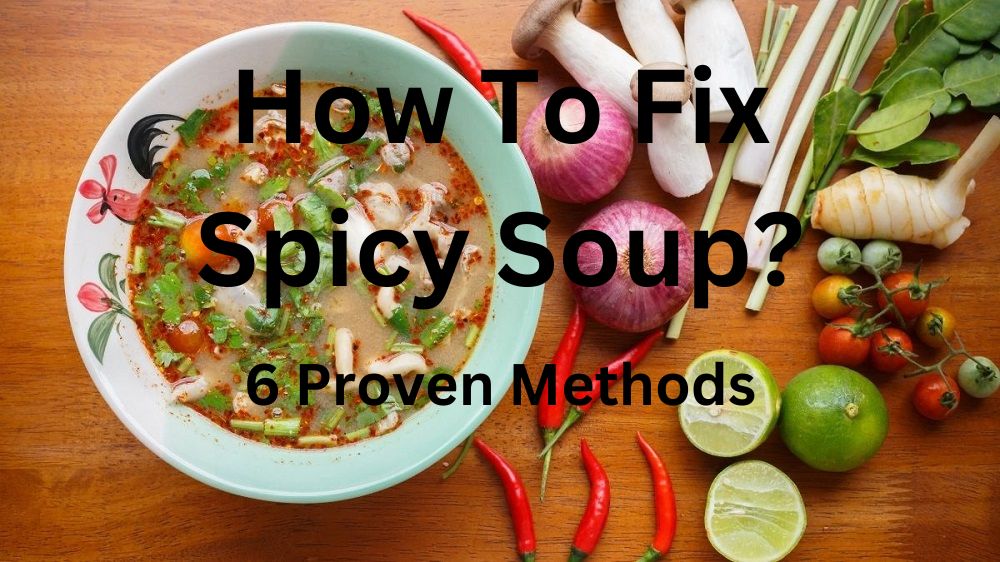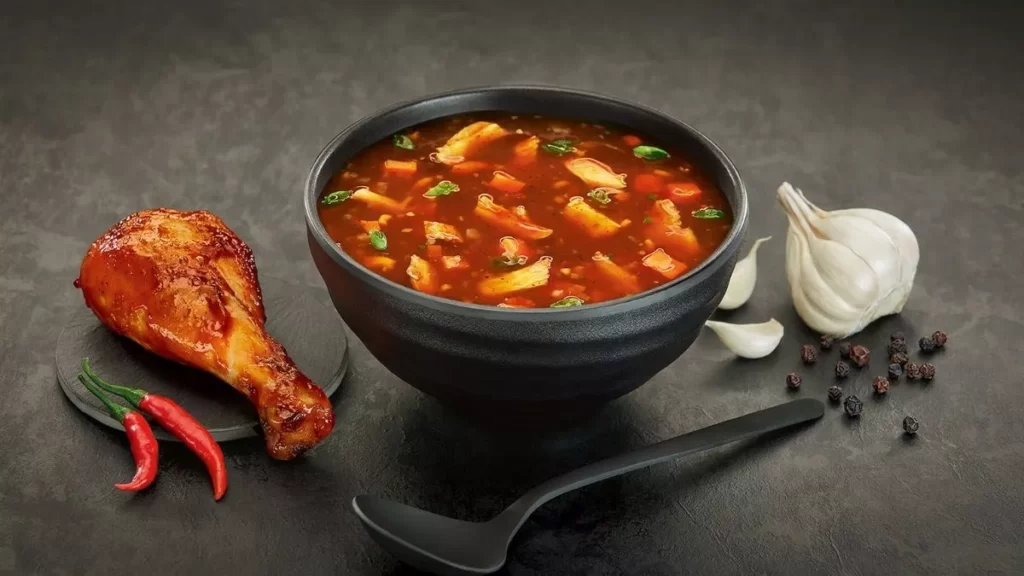
Soups were such an important part of my work life as quick one-stop comfort food, but I would mess it up by making it too spicy most of the time, thanks to my never-ending love for spices.
The best solutions to fix spicy soup are by diluting it with milk or broths, adding acidic ingredients like lime juice or vinegar, sweeteners like sugar or honey, and dairy-free options like nut butter, vegan creamer, or tahini.
When a spice is in liquid form, it is difficult to consume as it can blast the flavors ten times more than food in its solid state. Hence having a few options handy always help in masking the spiciness.
“Here is a one-stop solution that helps you not only level the spiciness but also in retaining its original flavor.”
Table of Contents
Dilution
One of the most popular facts about taming any dish is that diluting will milden its state whether it is too spicy or salty. Adding water to the soup can reduce the spiciness but it can also lose its flavor by becoming too bland. Here are a few other ways you can dilute the soup but can also retain its flavor-
- Coconut Milk: Adding coconut milk will not only tame the spiciness but will also add that extra boost of comforting taste to the soup making it hearty and filling. Adding full-fat coconut milk according to the quantity of the soup can be of great help.
- Note: Adding too much can make it too strong and might not appeal to everyone.
- Pro tip: Always add coconut milk after turning off the heat as burning coconut milk will increase the cholesterol content.
- Broths: Addin broths is one of the best ways to dilute any dish without compromising its taste. As broths come in a lot of varieties, there are several options to choose from. Vegetables, chicken, or any meat-based broth will do the trick in reducing the overall spiciness of the soup.
- Note: It is better to use unsalted broth if you are not a fan of salty soups.
Dairy
Adding dairy to spicy soups can help in balancing the flavors to a great extent. Spices like chili and pepper contain a compound called capsaicin which gives that hot and spicy taste to the dish when dairy is added to the soup, the casein proteins in it combine with capsaicin which will help neutralize the spiciness.
Here is what you can try adding to your stews
- Cream: Heavy cream works wonders when added to soups in a number of ways. Adding heavy cream to the soup will help in preventing curdling which is a common issue when adding dairy to dishes.
- Yogurt: Plain and unsweetened yogurt is one of the best ways to reduce the spiciness and thicken the soup with that extra dash of creaminess.
- Milk: As milk might be an option to reduce the spiciness in soups, it can get a little tricky as adding milk comes with a few limitations as well. Milk curdles due to its acidity, so one must be careful while adding milk to soups. Add milk slowly and in stages to retain the taste while combusting the heat.
- Note: Using freshly boiled milk as opposed to old milk helps in retaining the quality of the soup for a longer duration.
- Pro tip: Boil the dairy separately before adding it to the soup to avoid curdling.
Acidic Ingredients
For the longest time, Thai chefs have used acid-based ingredients like citrus, tomato, or vinegar in their soups to dampen their spiciness.
- Lemon or lime juice: Adding lemon juice as a finishing touch to your soups can help in enhancing the flavor by balancing the spices. Small quantities go a long way as adding too much might make it piquant.
- Note: Acidic ingredients don’t go well with all kinds of soups so pick up ingredients carefully before incorporating them.
- Pro tip: Add a splash of lemon juice in the end just before serving to keep the blend of all flavors fresh to consume.
- Vinegar: The one secret ingredient that adds life and locks the flavor of any stew or soup is vinegar. Adding vinegar helps in enhancing the intrinsic value of the soup. Be it balsamic, cider, distilled, or sherry. Vinegar has been a staple in all kitchens for ages and it is for a good reason, especially when it comes to balancing spiciness in soups. According to Chicago Tribune, the famous cookbook author James Peterson says that vinegar brings out the intrinsic nature of whatever you’re cooking. You will taste more of the other flavors, when you’re tasting and it appears that the flavors in a recipe are refusing to focus, a little vinegar will often do the trick.
- Note: Sherry vinegar is the best one for soups as it helps in adding the much-needed depth of flavor.
- Pro tip: Vinegar also helps in food preservation!
- Wine: Adding wine is one of many ways to bring the flavors together and enhance the aroma of the soup. According to Fine Cooking, in order to get the best flavor and to make sure the alcohol is cooked off, here is when to add the wine: For stews, braises, or long-simmering tomato sauces, add wine early in the simmering stage, after you have browned the meat and vegetables. Let the wine reduce a bit and then add the other liquids.
- Note: It is always good to cook with wines that you would drink or if it is a personal favorite as it adds a winy flavor to the soup
- Pro tip: Wines do not mask but fortify the flavor of the food so add accordingly.
Sweeteners
We have all been there when we had something too spicy and gulped a tablespoon of granulated sugar. Adding sweeteners to the soup does exactly like their name, it sweetens the dish and tones the spiciness down. Sweeteners like granulated sugar, honey, maple syrup, agave syrup, etc can help in reducing the spice but also change the flavor entirely. Here are a few that are widely used:
- Sugar: Sugar is always a handy option to add to any dish to make it less spicy and also add a sweet pinch to it. It is one of the most common methods used in Chinese cuisine. I always add some sugar to my tomato soups.
- Pro tip: Adding half a teaspoon of sugar for every four cups of liquid is always better to balance the flavors evenly.e)
- Honey: Adding honey to soups gives it a subtle sweetness and flavor. It is also a good substitute for granulated sugar as it is a healthier option while also reducing spiciness.
- Pro tip: A pinch of honey goes a long way so be mindful while adding it.
Starchy Ingredients
Starch is always known to soak up the flavors, so if you are a fan of savory soups with rice or pasta, this would be a great option to mask the spiciness of the soup. According to delishably.com, the method is held by some to have merely a placebo effect since the starchy addition does not selectively absorb the spice but instead acts like a sponge. In other words, you are not actually reducing spice, but just adding the bland bulk of starch to offset it.
- Pro tip: Starch can also be used as a quick fix to thicken soups.
Vegan and dairy-free options to reduce the spice
For vegans and lactose-intolerant folks out there, there are a few amazing vegan options that can be used to reduce or dampen the spiciness without compromising on the depth of the flavor.
- Nut Milk: Nut milk is one of the best dairy-free options one can add in order to balance the spiciness of soups. There are a number of nut milk options to try out like almond milk, soy milk, oat milk, rice milk, etc to boost the flavor of the soup while reducing its spiciness. Adding oat milk and vegetable broth to the base of the soup will also help greatly.
- Pro tip: Almond milk is the best option to add to soups as it does not impart much flavor when added by giving it a thick creamy consistency.
- Vegan Butters and cheese: Vegan butter and cheese give the same results to the soup as the dairy options. If lactose intolerant, stocking up on vegan butter and cheese is the best option to add to soups.
- Note: Vegan butter and cheese are usually made from soy, so people resistant to soy-based items must stay away!
- Nut Butter: Want to reduce the spiciness and also add a bunch of protein to your soup? Then this is for you! Nut butter is a great option for vegans as they help check your daily protein intake and add it to soups, it imparts that nutty taste and reduced spice and helps thicken the soup to an extent.
- Tahini: Open Sesame! In short words, tahini is a sesame seed paste that is widely used in middle eastern dishes. Tahini is known to have a lighter and earthy taste than all other nut butter which makes it an amazing choice for soups and it contributes greatly to its savory taste.
- Pro tip: Tahini is a great substitute if you are allergic to peanuts, as it can replace peanut butter in almost everything!
- Avocado: Sounds very unfamiliar, but avocado does help in reducing the spice while adding light creaminess to the soup. Adding avocados is a great way to thicken the soup without any dairy products. It also enhances the taste without giving a weird taste to the soup.
- Pro tip: It is always better to use an overripe avocado as it is easier to blend compared to the semi-ripe and unripe ones.
- Vegan Creamers: If you run out of all the other options mentioned above, vegan creamers are here to save your soup! Nondairy options like soy creamers, oat creamers, coconut cream, etc are easy pre-packaged options to add to soups in order to fix their spiciness. Vegan creamers can also be used as great toppings for soups.
- Pro tip: The best homemade coconut cream recipe is to simply chill a can of full-fat coconut milk in the fridge overnight and use it as and when needed to balance soups.

How To Fix Spicy Soup – Conclusion
Soups have been and will always be a staple, savory, and quick comforting meal for everyone around the globe.
As the internet is a one-stop solution to almost all kinds of soups you might want to make, some instances might hinder your oh-so-perfect bowl of happiness.
But it is never a lost cause as there are many ways to fix your soup to bring back the flavor and taste for your perfect bowl of happiness without having to redo the whole thing again (which none of us want).
Please feel free to like and comment with your thoughts on other ways to entice soups to make them perfect all over again.
